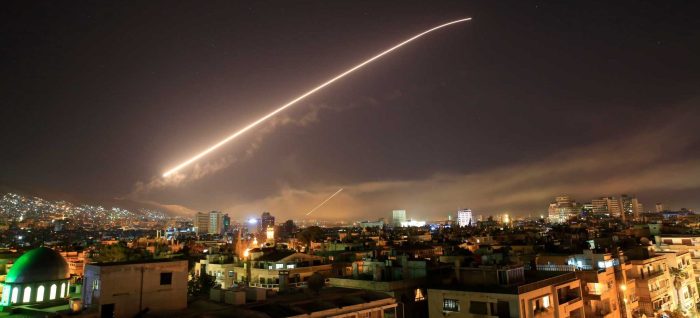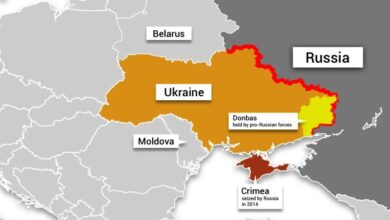
Will Middle East Tensions Spark Another Energy Crisis?
Will tensions in the Middle East lead to another energy price shock? This question is increasingly on everyone’s minds as geopolitical instability in the region continues to escalate. The Middle East is home to a significant portion of the world’s oil reserves, and any disruption to production or supply could have a devastating impact on global energy markets.
The region has a history of energy price shocks, with past events leaving lasting scars on the global economy. From the 1973 oil crisis to the 2008 spike in prices, the world has witnessed the devastating consequences of instability in the Middle East.
The current situation is particularly concerning. The ongoing conflicts in Yemen, Syria, and Iraq have already disrupted oil production and supply chains. The rivalry between Saudi Arabia and Iran is also a major source of tension, with both countries vying for regional dominance.
The United States, which has long played a key role in maintaining stability in the region, is now facing challenges from both within and outside its borders. This complex geopolitical landscape raises serious questions about the future of energy security and the potential for another energy price shock.
Current Middle East Tensions

The Middle East is a region rife with geopolitical tensions, often fueled by historical conflicts, religious differences, and competition for resources, particularly energy. These tensions can have a significant impact on global energy markets, impacting oil and gas production, transportation, and prices.
Impact of Current Tensions on Energy Markets
The current tensions in the Middle East are complex and multifaceted, involving several key players with varying interests and agendas. The ongoing conflict in Yemen, the rivalry between Saudi Arabia and Iran, and the US withdrawal from the Iran nuclear deal are just a few examples.
These conflicts have significant implications for energy markets, impacting oil production, supply chains, and global energy prices.
- Yemen Conflict:The ongoing conflict in Yemen has disrupted oil production and transportation in the region, impacting global supply. The Houthis, a Yemeni rebel group, have targeted oil infrastructure and shipping lanes, creating uncertainty and volatility in the energy market.
- Saudi Arabia-Iran Rivalry:The rivalry between Saudi Arabia and Iran, the two dominant powers in the region, has a significant impact on energy markets. The two countries are major oil producers and have a long history of political and economic competition. Their rivalry has often led to tensions in the region, impacting oil prices and supply.
- US Withdrawal from Iran Nuclear Deal:The US withdrawal from the Iran nuclear deal in 2018 reimposed sanctions on Iran, limiting its ability to export oil and impacting global supply. This has further contributed to volatility in the energy market and raised concerns about potential disruptions.
It’s a delicate balancing act: keeping the lights on while also ensuring that those in power are held to the highest standards. The future of energy prices is a complex equation, and one that we’ll be watching closely in the months to come.
3>Role of Major Players in Mitigating Tensions
The role of major players in the region, including Saudi Arabia, Iran, and the United States, is crucial in mitigating tensions and ensuring energy security.
- Saudi Arabia:Saudi Arabia, the world’s largest oil exporter, has a significant influence on global energy markets. The country has historically played a role in stabilizing oil prices and ensuring supply. However, Saudi Arabia’s actions in recent years, including the OPEC+ production cuts, have contributed to higher oil prices.
- Iran:Iran, a major oil producer, has been subject to US sanctions since the withdrawal from the nuclear deal. The sanctions have limited Iran’s ability to export oil, impacting global supply. Iran’s role in mitigating tensions in the region is complex and involves balancing its own interests with those of other regional players.
- United States:The United States, a major consumer of oil and gas, has a significant interest in ensuring energy security. The US has been involved in regional conflicts, such as the war in Iraq, and has sought to maintain its influence in the region.
However, the US withdrawal from the Iran nuclear deal has contributed to tensions and uncertainty in the energy market.
Impact of Tensions on Energy Infrastructure and Supply Chains
The tensions in the Middle East have had a significant impact on existing energy infrastructure and supply chains, creating challenges for the smooth flow of oil and gas.
The potential for another energy price shock in the wake of Middle East tensions is a serious concern. But while the world grapples with geopolitical instability, it’s also facing a major shift in college athletics, as exemplified by the recent lawsuit filed by Reggie Bush, which could reshape the landscape for the NCAA, USC, and the Pac-12.
What Reggie Bush’s NIL lawsuit means for the NCAA, USC, and Pac-12 is a story worth following, as it could have far-reaching consequences for the future of college sports, just as energy prices are a major factor in global economic stability.
- Pipeline Attacks:Pipeline attacks in the region have become increasingly common, disrupting oil and gas transportation. These attacks can cause significant damage to infrastructure, leading to production losses and supply disruptions.
- Shipping Disruptions:Tensions in the region have also led to disruptions in shipping lanes, impacting the transportation of oil and gas. The Strait of Hormuz, a vital shipping route for oil exports from the Middle East, has been a source of tension and potential disruption.
- Investment Uncertainty:The ongoing tensions in the region have created uncertainty for energy companies, making them hesitant to invest in new infrastructure projects. This uncertainty can impact the long-term supply of oil and gas, potentially leading to higher prices.
Historical Energy Price Shocks

The Middle East has been a major source of global energy supply for decades, and events in the region have often had a significant impact on global energy prices. Past energy price shocks serve as a historical backdrop for understanding the potential for another price surge in the current context.
By examining these past events, we can gain insights into the key factors that drive price volatility and the potential consequences of future disruptions.
The 1973 Oil Crisis
The 1973 oil crisis, triggered by the Arab oil embargo, marked a turning point in global energy markets. The embargo, imposed by OPEC members in response to US support for Israel during the Yom Kippur War, resulted in a dramatic reduction in oil production and exports.
The price of oil quadrupled within a year, leading to a global economic recession and fueling inflation.
- Key Factors:The embargo, coupled with the growing demand for oil, created a significant supply shortage, driving up prices. The cartel’s coordinated action demonstrated the power of OPEC in influencing global energy markets.
- Impact:The oil crisis led to widespread economic hardship, including fuel shortages, inflation, and unemployment. It also spurred investments in alternative energy sources and energy conservation measures.
The 1979 Oil Crisis, Will tensions in the middle east lead to another energy price shock
The Iranian Revolution in 1979, followed by the Iran-Iraq War, led to another major disruption in global oil supply. The revolution caused a decline in Iranian oil production, while the war further reduced supply and heightened tensions in the region.
The price of oil doubled within a year, leading to a second global economic recession.
- Key Factors:The geopolitical instability in Iran and the ongoing war in the region significantly impacted oil production and exports. The disruption in supply, coupled with increased demand, contributed to the price spike.
- Impact:The 1979 oil crisis exacerbated the economic difficulties caused by the 1973 crisis. It further accelerated the development of alternative energy sources and energy conservation strategies.
The 1990-1991 Gulf War
The Gulf War, triggered by Iraq’s invasion of Kuwait, also led to a significant increase in oil prices. The war disrupted oil production in Kuwait, a major oil producer, and created uncertainty about future supply. The price of oil rose sharply, but the impact was less severe than previous crises due to the relatively short duration of the war and the availability of alternative sources of oil.
- Key Factors:The disruption of oil production in Kuwait and the uncertainty surrounding future supply contributed to the price increase. The war also highlighted the importance of the Persian Gulf region as a key oil producing area.
- Impact:The price spike had a significant impact on global economies, particularly in countries heavily reliant on oil imports. It also spurred efforts to reduce dependence on Middle Eastern oil.
The 2003 Iraq War
The US-led invasion of Iraq in 2003, while not directly causing a major price shock, contributed to ongoing price volatility in the oil market. The war created uncertainty about Iraqi oil production and exports, and the subsequent insurgency further destabilized the region.
- Key Factors:The war in Iraq, coupled with increasing global demand for oil, contributed to price volatility. The uncertainty surrounding Iraqi oil production and the potential for future disruptions added to market concerns.
- Impact:The war in Iraq exacerbated existing price pressures and fueled concerns about energy security. It also highlighted the importance of political stability in oil-producing regions.
Potential Triggers for Another Energy Price Shock
The Middle East is a volatile region, and tensions there can have a significant impact on global energy markets. A number of factors could trigger another energy price shock, potentially leading to disruptions in oil production, sanctions on major exporters, or escalating conflicts.
These events could have a profound impact on energy prices, supply chains, and global economies.
Disruptions to Oil Production
Disruptions to oil production are a major concern, as they can lead to supply shortages and price increases. Several factors could disrupt oil production in the Middle East, including:
- Political Instability:Political instability and unrest in oil-producing countries can lead to disruptions in production, as seen in recent years in Libya and Iraq. The ongoing conflict in Yemen also threatens oil production in the region.
- Terrorist Attacks:Terrorist attacks on oil infrastructure, such as pipelines and refineries, can also disrupt production. The 2019 attack on Saudi Arabia’s Abqaiq oil processing facility, which temporarily halved the country’s oil output, is a prime example.
- Natural Disasters:Natural disasters, such as earthquakes, floods, and hurricanes, can also disrupt oil production. The 2010 Deepwater Horizon oil spill in the Gulf of Mexico is a reminder of the potential impact of such events.
- Cyberattacks:Cyberattacks on critical oil infrastructure, such as control systems and pipelines, could disrupt production and distribution. The recent cyberattacks on the Colonial Pipeline in the United States, which led to fuel shortages on the East Coast, highlight the vulnerability of energy infrastructure to cyber threats.
These disruptions could have a significant impact on energy prices, as they would reduce the global supply of oil. The resulting price increases could have a ripple effect throughout the global economy, leading to higher prices for goods and services, and potentially slowing economic growth.
The escalating tensions in the Middle East are certainly a cause for concern, especially given the potential for another energy price shock. It’s a complex situation with many moving parts, and it’s hard to predict how things will unfold. Meanwhile, it seems like everyone’s caught up in the latest political drama, with Kamala Harris’s recent comments about self-defense making headlines.
But let’s not forget the real issues at stake, like the potential for another energy crisis that could impact us all.
Sanctions on Major Exporters
Sanctions on major oil exporters, such as Iran and Venezuela, could also lead to energy price shocks. Sanctions can limit the ability of these countries to export oil, reducing global supply and driving up prices. The impact of sanctions on oil prices depends on the severity of the sanctions and the availability of alternative sources of supply.
For example, the U.S. sanctions on Iran have led to a reduction in Iranian oil exports, contributing to higher oil prices.
Escalating Conflicts
Escalating conflicts in the Middle East, such as the ongoing conflict between Israel and Palestine, could also trigger an energy price shock. Conflicts can disrupt oil production, transportation, and refining, leading to supply shortages and price increases. Additionally, conflicts can increase geopolitical tensions and uncertainty, making investors hesitant to invest in the oil sector, further impacting supply and prices.
Mitigation Strategies and Responses

The possibility of another energy price shock due to Middle East tensions demands proactive strategies to minimize its impact. Diversifying energy sources, building strategic reserves, and fostering international cooperation are crucial elements in mitigating the effects of such an event.
Government and International Organization Roles
Governments and international organizations play a vital role in addressing energy security concerns and managing potential price spikes. Their actions can influence the energy market and provide a framework for global cooperation.
- Promoting Energy Diversification:Governments can encourage investments in renewable energy sources, such as solar, wind, and geothermal, to reduce dependence on fossil fuels. They can also support the development of alternative energy technologies, such as nuclear power, to diversify the energy mix.
Examples include the European Union’s Green Deal, which aims to transition to a climate-neutral economy by 2050, and China’s ambitious renewable energy targets.
- Building Strategic Reserves:Maintaining strategic oil reserves is crucial for countries to buffer against supply disruptions. Governments can establish or expand national reserves and coordinate with international partners to ensure a collective response to potential crises. The International Energy Agency (IEA) has a system for releasing oil reserves in times of emergency, as demonstrated during the 2011 Libyan crisis.
- Enhancing International Cooperation:Governments can work together to establish global energy security frameworks, coordinate responses to crises, and share information on energy markets. International organizations like the IEA and OPEC can facilitate dialogue and cooperation among member countries. Examples include the IEA’s Emergency Response Mechanism, which allows for coordinated releases of oil reserves, and OPEC’s efforts to stabilize oil prices.
Effectiveness of Past Mitigation Strategies
Past mitigation strategies have had varying degrees of success in addressing energy price shocks.
- Diversification:The shift towards renewable energy sources has been successful in some regions, but dependence on fossil fuels remains high in many countries. The pace of transition needs to accelerate to achieve meaningful diversification.
- Strategic Reserves:Strategic oil reserves have proven effective in mitigating short-term supply disruptions, but their impact on long-term price stability is limited. Maintaining and replenishing these reserves requires significant financial resources and coordination among nations.
- International Cooperation:International cooperation has played a role in stabilizing energy markets, but challenges remain in coordinating responses and achieving consensus among countries with divergent interests. The 2011 Libyan crisis highlighted the potential for coordinated action, but also exposed the limitations of cooperation when faced with complex geopolitical issues.
Economic and Social Impacts: Will Tensions In The Middle East Lead To Another Energy Price Shock
An energy price shock, especially one stemming from geopolitical instability in the Middle East, would have far-reaching economic and social consequences. These impacts extend beyond the immediate price increases at the pump, rippling through global economies and societies, potentially triggering instability and hardship.
Economic Impacts
A sharp increase in energy prices would have a significant impact on global economies. The most immediate effect would be inflation, as businesses pass on higher energy costs to consumers through increased prices for goods and services. This would erode purchasing power, leading to a decline in consumer spending and ultimately reduced economic growth.
The severity of these impacts would depend on the magnitude and duration of the price shock, as well as the vulnerability of individual economies to energy price fluctuations.
Social Impacts
The social impacts of an energy price shock can be profound. Higher energy costs disproportionately affect low-income households, which spend a larger percentage of their income on energy. This can lead to increased povertyand exacerbate existing inequalities. The economic hardship resulting from a price shock can also fuel social unrest and political instability, as citizens become frustrated with rising living costs and the perceived lack of government action.
Alternative Energy Sources and the Transition
The potential for another energy price shock highlights the urgency of transitioning to a more resilient and sustainable energy system. Alternative energy sources, particularly renewable energy and nuclear power, offer promising avenues to mitigate the impact of future energy price volatility.
The Role of Alternative Energy Sources
The transition to alternative energy sources is crucial for diversifying energy supply and reducing dependence on volatile fossil fuels.
- Renewable Energy: Renewable energy sources, such as solar, wind, hydro, geothermal, and biomass, are inherently abundant and sustainable. Their deployment can reduce reliance on imported fossil fuels, enhance energy security, and lower greenhouse gas emissions. For instance, the European Union’s ambitious renewable energy targets have significantly reduced its dependence on Russian gas.
- Nuclear Power: Nuclear power remains a significant source of low-carbon electricity, providing a consistent and reliable baseload energy supply. Despite concerns about nuclear waste and safety, advancements in reactor technology and waste management are making nuclear power more viable and sustainable.
Notably, France, which relies heavily on nuclear power, has maintained stable energy prices and reduced carbon emissions.
The Potential for a Rapid Transition
A rapid transition to alternative energy sources is feasible, but it requires significant investments, policy support, and technological advancements.
- Investment and Policy Support: Governments and private investors must prioritize investments in renewable energy infrastructure, research and development, and grid modernization. Policies such as feed-in tariffs, tax credits, and carbon pricing mechanisms can incentivize the deployment of renewable energy and encourage innovation.
- Technological Advancements: Continued advancements in renewable energy technologies, such as improved solar panel efficiency and battery storage capacity, are essential for making renewable energy more cost-effective and reliable. Similarly, advancements in nuclear reactor technology and waste management are crucial for increasing the safety and sustainability of nuclear power.
International Cooperation and Technological Advancements
International cooperation and technological advancements are critical for accelerating the transition to a more sustainable energy future.
- International Cooperation: Sharing best practices, knowledge, and technologies across borders is essential for scaling up renewable energy deployment and promoting nuclear power safety. International agreements and collaborations can foster investment, reduce costs, and accelerate the transition. Examples include the International Energy Agency’s Sustainable Development Scenario, which Artikels a pathway for achieving net-zero emissions by 2050.
- Technological Advancements: Breakthroughs in areas such as energy storage, grid integration, and renewable energy generation technologies are crucial for overcoming challenges and accelerating the transition. Investments in research and development, particularly in areas like advanced battery technologies, smart grids, and hydrogen energy, are essential for achieving a more sustainable energy future.






